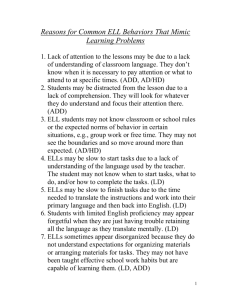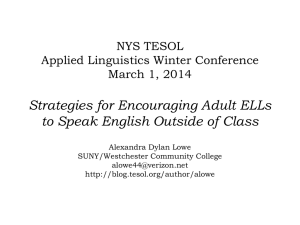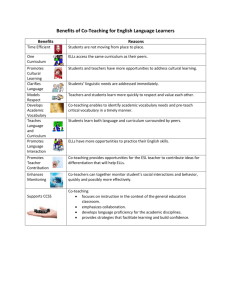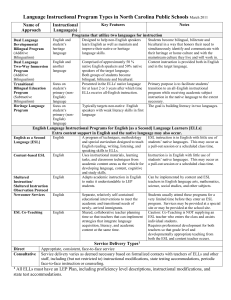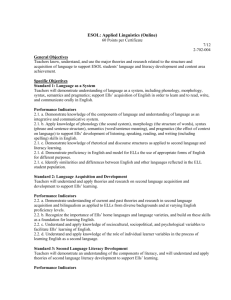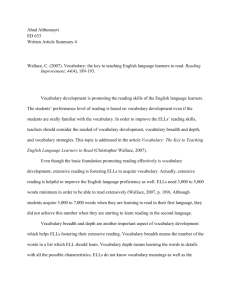Preparing Teachers of English Language Learners
advertisement
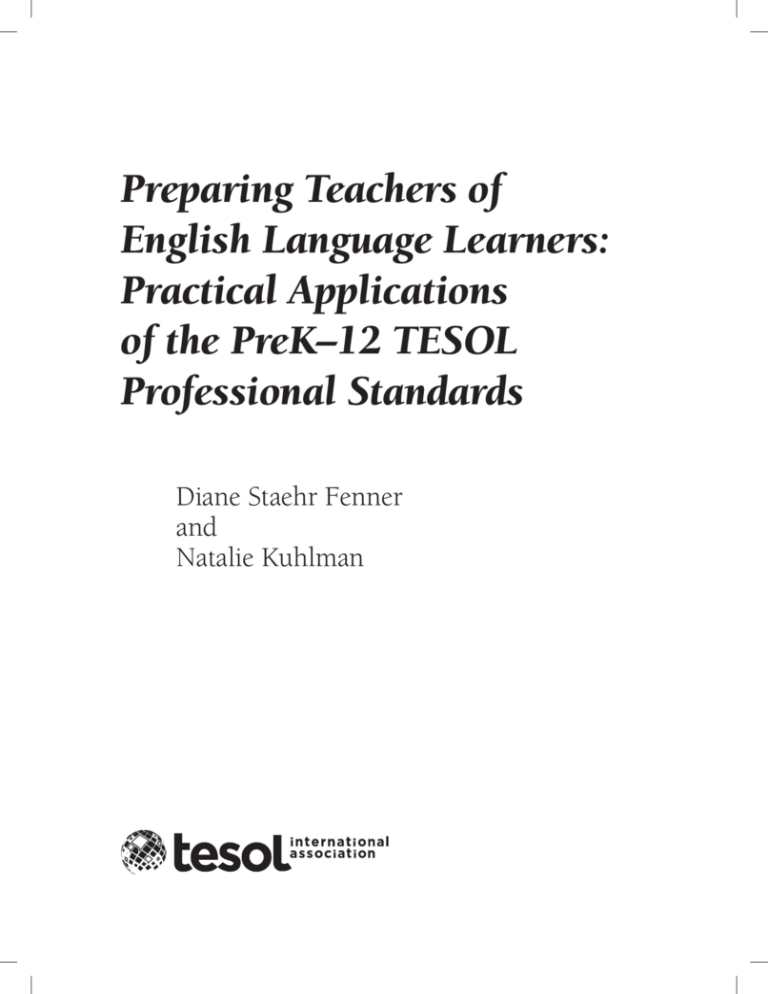
Preparing Teachers of English Language Learners: Practical Applications of the PreK–12 TESOL Professional Standards Diane Staehr Fenner and Natalie Kuhlman Application of Standards by Domain Chapter 6 Domain 1: Language This chapter focuses on the first domain of the TESOL P–12 Professional Teaching Standards, Language, and its application to program development, NCATE/CAEP recognition, and professional development. We begin with a description of the domain and then focus on the application of each of the two standards found in this domain for the three audiences and purposes of this book: program development, NCATE/CAEP recognition, and professional development. It should be noted that the examples are suggestions and are not intended to be prescriptive in nature. We encourage those who use the TESOL P–12 Professional Teaching Standards to adapt them to their own contexts so that they will be the most useful. The Structure of Domain 1: Language Table 1 lists the two standards of this domain along with the performance indicators that are used to exemplify and support them. Overview of Domain 1 This domain defines the content that is at the core of being a teacher who works with ELLs, as well as the role of the teacher in applying this knowledge of English to foster ELLs’ acquisition of the language in the classroom. It is important for ESL teachers and content area teachers1 who instruct ELLs to have a conscious knowledge of the components of language as a system (Standard 1.a). Domain 1 therefore addresses the fundamental knowledge a teacher in this field should have to effectively engage in the task of addressing the language needs of ELLs so that they can acquire grade-level content such as mathematics, science, and English language arts. This knowledge of English goes beyond having a grasp of English grammatical rules to having an understanding of language as a system of rules—and beyond. This fundamental knowledge includes awareness and understanding of the separate components of the language system, such as phonology, morphology, semantics, and pragmatics or discourse. As part of this domain, teachers are also expected to be aware of how language changes and how users of language have access to different varieties of language; teachers must also be aware of how various languages are similar or different. 1 Content area teachers are non-ESL or bilingual education teachers who instruct students in subjects such as mathematics, English language arts, social studies, and science. 77 Table 1. Organization of Domain 1: Language Domain 1: Candidates know, understand, and use the major theories and research related to the structure and acquisition of language to help English language learners (ELLs) develop language and literacy and achieve in the content areas. 1.a. Language as a System Candidates demonstrate understanding of language as a system, including phonology, morphology, syntax, pragmatics and semantics, and support ELLs as they acquire English language and literacy in order to achieve in the content areas. 1.a.1. Demonstrate knowledge of the components of language and language as an integrative system. 1.a.2. Apply knowledge of phonology (the sound system), morphology (the structure of words), syntax (phrase and sentence structure), semantics (word/sentence meaning), and pragmatics (the effect of context on language) to help ELLs develop oral, reading, and writing skills (including mechanics) in English. 1.a.3. Demonstrate knowledge of rhetorical and discourse structures as applied to ESOL learning. 1.a.4. Demonstrate proficiency in English and serve as a good language model for ELLs. 1.b. Language Acquisition and Development Candidates understand and apply theories and research in language acquisition and development to support their ELLs’ English language and literacy learning and contentarea achievement. 1.b.1. Demonstrate understanding of current and historical theories and research in language acquisition as applied to ELLs. 1.b.2 Understand theories and research that explain how L1 [first language] literacy development differs from L2 [second language] literacy development. 1.b.3. Recognize the importance of ELLs’ L1s and language varieties and build on these skills as a foundation for learning English. 1.b.4. Understand and apply knowledge of sociocultural, psychological, and political variables to facilitate the process of learning English. 1.b.5. Understand and apply knowledge of the role of individual learner variables in the process of learning English. Teachers also need to be fluent in social and academic English so that they can serve as role models for students. This need for fluency is especially apparent as numerous nonnative speakers of English teach ELLs in the United States as well as other countries. TESOL recognizes and supports these nonnative speakers in ESL/EFL teaching positions by, among other things, dedicating an interest section to them so they can share resources and support. There are also native speakers of English who may use a nonacademic or other variety of English. However, all teachers who work with ELLs, including native as well as nonnative speakers of English, need to be fluent in academic English, which is needed for students to be successful in school and society. Not only do ESL teachers need to be highly knowledgeable about the content they are teaching, the English language, they also must be able to apply theories and research on the process of acquiring English in order to support ELLs as these students learn academic English and content simultaneously (Standard 1.b). And although the goal for ELLs is second language acquisition (SLA), ESL teachers who are teaching younger students also need to know about first language acquisition and development. Teachers should not expect more of students learning English than of their native-English-speaking (NES) peers. For example, it is not uncommon for NES 5-year-olds to generalize the past tense. For example, they may say, “I goed,” before they realize that there are irregular verbs, too. For teachers in secondary schools, on the other hand, it is useful to be familiar with the kinds of changes that occur as students 78 TESOL Professional Standards for Teacher Preparation: Practical Applications become young adults. Anxiety and not wanting to look foolish in front of friends may affect these students’ ability to learn a second language. Also, research has shown that acquiring English as a second or additional language2 takes a long time, with students requiring several years or more to acquire academic English (Bailey, 2010; Cummins, 1991; Thomas & Collier, 2002). Domain 1 stresses that ESL teachers need to be aware of research findings regarding SLA for ELLs and their impact on models for providing ELLs with language support. For example, researchers who have studied various models of education for ELLs have found that those who have bilingual or ESL instruction only until the second or third grade (when students are learning to read instead of reading to learn) may appear to be competent in academic English, but they may have acquired only a limited amount and may not be sufficiently literate in English. Consequently, in the fourth grade, when the focus turns to reading to learn, these students tend to fall behind their NES peers and ELLs who received two-way bilingual immersion or continued ESL or bilingual instruction (Thomas & Collier, 2002). Another reason that ESL and content area teachers need to study SLA is to address the fact that many teachers believe ELLs are fluent in English after a couple of years because they may use social English with few errors. These teachers may believe ELLs who have developed social English are ready to be taught and assessed in the content areas without linguistic modifications, accommodations, or language support because the ELLs may sound as if they are fluent in English. However, these students may lack the deeper, more complex level of academic English that is crucial for them to achieve in the content areas. The application of Standard 1.b, Language Acquisition and Development, to an ESL teacher preparation program enables teacher candidates and educators to understand the communicative, social nature of language and reinforces the idea that learning a language (whether the first or the fifth language) is a multidimensional process that depends on a complex set of variables. Some of these variables include an ELL’s prior formal education, age of arrival in the United States, stage of development, amount of literacy in the L1, motivation, and even personality. This standard focuses on the foundation set by the L1 and builds awareness about personal and affective variables in language learning. This standard then translates this knowledge about the complexities of SLA into instruction. Program Development Several factors must be considered when designing an ESL teacher licensure program that fully addresses and incorporates the two standards found in Domain 1. For example, it would be easy to create an ESL preparation program to meet Standard 1.a by simply requiring an introductory linguistics course that would cover phonology, morphology, syntax, and semantics, the basics of language, and perhaps another course on first and second language acquisition. 2 TESOL recognizes that many ELLs learn English as an additional, not a second, language (e.g., a third or even fourth language). We use the term English as a second language and second language acquisition to refer to all ELLs, no matter how many languages they may have learned before English. Chapter 6: Domain 1: Language 79 In a standards-based program, however, these linguistic foundations would be continually applied to ELLs, not taught in isolation. For example, in one university program, a faculty member used a third-grade English language arts textbook to demonstrate why learning about these linguistic fundamentals was critical for all teachers, particularly for those who would teach ELLs. Any ESL textbook intended for K–12 students would also demonstrate this. Some universities even offer specific courses such as Linguistics for Teachers, and several textbooks specifically address the basics of linguistics and language diversity for teachers (e.g., Andrews, 2001; Cleary & Linn, 1993; Freeman & Freeman, 2004). These books help make the connection between linguistics and classroom teaching that are needed for a standards-based preparation program. Many linguistics courses have large enrollments of teacher candidates; consequently, instructors tend to give multiple-choice exams in lieu of practical projects. By nature of their design, multiple-choice exams do not typically give ESL teacher candidates the opportunity to apply what they are learning to the ESL classroom. Various projects would enable teacher candidates to apply their knowledge of the content found in Domain 1. One might be to do case studies of individual ESL students. Each teacher candidate would spend time in a classroom, tutoring, or other setting with one ELL, profiling the student’s pronunciation (using knowledge of phonology), grammar (morphology and syntax,) and vocabulary (semantics). The teacher candidate would also observe and note the student’s reading and writing abilities in and level of speaking and listening in English. The teacher candidate might also learn about other factors that influence the acquisition of English, including the student’s family background, such as time in the home country and in the United States, other family members who either have learned or are learning English, and how the student feels about learning English. There are a variety of such projects that could be used as part of the ESL teacher preparation program. NCATE/CAEP Recognition This section provides a detailed examination of the ways in which programs can document how they are meeting Standards 1.a and 1.b of Domain 1 for NCATE/CAEP recognition reports. Standard 1.a. Language as a System ESL teacher education programs typically use either a state licensure test or an assessment developed by the program itself to demonstrate that their teacher candidates meet Standard 1.a. These include the Praxis II-ESOL or another state-developed test or a comprehensive exam, lesson plan, or student teaching evaluation. Caution should be exercised when using a state licensure test by itself as documentation of meeting a standard. Typically, a state licensure test alone is not a sufficient way for teacher candidates to demonstrate their ability to apply what they know in the classroom as it relates to Standard 1.a or any other TESOL standard. Although it is not TESOL or NCATE/CAEP policy, it is beneficial for TESOL reviewers to see an additional assessment or more beyond a state licensure test that addresses each standard. 80 TESOL Professional Standards for Teacher Preparation: Practical Applications The Praxis II-ESOL, revised in 2009, contains 30 items (25% of the test) on the analysis of student language production; these items are related to Standard 1.a (Educational Testing Service, 2009). If your program uses a comprehensive exam to demonstrate candidates meeting Standard 1.a, your report compiler must provide detailed information on how your exam measures candidates’ knowledge and applies the components of Standard 1.a to practice. It is often easier for programs to design assessments in which candidates demonstrate their knowledge through an exam; as reviewers we often see multiple-choice exams submitted as evidence that a program is addressing Standard 1.a. Although it is possible to design a multiplechoice exam in which candidates apply their knowledge of P–12 ELLs’ use of language, multiple-choice tests do not usually provide the opportunity for teacher candidates to apply the skills they have learned. For example, candidates could analyze ELLs’ speech and/or writing and answer questions related to an error analysis. If your program uses an exam to measure candidates’ progress toward this standard, you will need to provide a detailed alignment of how many items your program has developed that address Standard 1.a and which components of Standard 1.a they address. If possible, it is very beneficial to the report reviewers to be able to read the actual test in use. Based on the low frequency with which compilers submit such assessments, it seems to be more challenging for programs to design assessments that enable their candidates to apply their knowledge of Standard 1.a to practice in a performance-based assessment. For that reason, we provide an example of how performance-based assessments could be used to demonstrate candidates meeting this standard. Teachers College at Columbia University recently implemented an assessment, submitted as Assessment 5 (effects on student learning), to demonstrate candidates’ meeting of Standard 1.a as well as other TESOL Standards. This assessment consists of planning, implementing, and reflecting on a Sheltered Instruction Observation Protocol lesson. Candidates design a lesson based on New York State Learning Standards that is tailored to the needs of a specific class. The lesson is videotaped, and candidates use a video reflection form to reflect on the lesson and its effectiveness, providing evidence for Standard 1.a as well as other TESOL Standards. As part of lesson planning, candidates must write content and language objectives, and they are provided with guiding questions for writing language objectives. Sample video reflection questions ask candidates to reflect on how they developed and included instruction on language objectives and how they scaffolded language during their lessons. Candidates are assessed in part on whether the lesson they designed met multiple criteria that align with Standard 1.a, and they must state what students should be able to do related to language as a result of the lesson. They need to show instruction in the four domains, the language functions, and in language structures students will need to use in order to participate in the language functions. Although the candidates’ lessons do not specifically address segmented elements of language such as morphology, phonology, etc., the lesson ensures that they must first understand language as a system before being able to implement cohesive elements of language as a whole through an authentic lesson. Chapter 6: Domain 1: Language 81 Standard 1.b. Language Acquisition and Development To document how they address the content knowledge in Standard 1b, teacher education programs often submit grades, a comprehensive exam, a content-based portfolio, a case study, or action research. Parts of the standard may also be met through lesson plans and clinical practice. It is common for institutions to create an assessment around a case study of a student who is learning English as a second or additional language in order to address Standard 1.b. This assessment shows how institutions can go beyond course grades or a multiple-choice test, by using an action research paper so that candidates can demonstrate their knowledge of SLA. Here we describe what the University of Maryland College Park submitted in spring 2011 for Assessment 2 (content knowledge), which addresses Standard 1.b. This assessment provides an example of how a program could submit an action research paper that synthesizes perspectives of SLA, going beyond course grades or a multiple-choice test to demonstrate candidates’ applications of components of Standard 1.b. Candidates enrolled in the University of Maryland College Park’s Second Language Acquisition course are required to write a research paper. This multicomponent project involves synthesizing information from a literature review, teacher and learner interviews, and a classroom observation. It is also used to evaluate understanding of foundational SLA knowledge in the course. The university has modified this assignment in recent years to ensure that candidates can apply their understanding to teaching and learning. Candidates engage in an inquiry-based case study to apply SLA theories to real teaching situations. The assignment requires that candidates choose a topic in SLA, learn about it in depth by reading original research and writing a literature review, and then produce a written reflection and synthesis on the topic’s application to actual classroom settings from interviews and classroom observations. In their research paper, candidates must synthesize findings from the following data sources: (a) language learning autobiography; (b) language learner interview; (c) classroom observations; (d) teacher interview; and (e) annotated bibliography, including consideration of the ways that the different theoretical perspectives discussed throughout the course may explain, describe, and/or theorize these experiences. Candidates link their inquiry to SLA concepts, theories, and issues discussed in class. Their paper integrates their personal experiences with class readings, reflections on these readings, and class discussions. Their paper should demonstrate a thorough understanding of class readings and should integrate readings from class, additional readings, their personal experience, and their reflections and theorizing, including their ideas about pedagogical implications. Professional Development Domain 1 lends itself to multiple ways of applying its two standards through professional development to teachers and administrators at the school, district, and state levels. Because a conscious knowledge of language is a necessity in order to teach language, when conducting professional development workshops related to Domain 1, it is suggested that an informal survey of participants be undertaken to determine the extent to which they are competent in the basics of language structure and SLA. 82 TESOL Professional Standards for Teacher Preparation: Practical Applications Standard 1.a If teachers do not have knowledge of language structure, then they cannot teach ELLs academic English. If the informal survey mentioned earlier finds that a significant number of teachers are not knowledgeable in the area of language structure, then the basic concepts of phonology, morphology, semantics, pragmatics, and discourse need to be presented to them. In addition, the differences between written and spoken language and social and academic language should be included within the context of language learning. Because ELLs must be able to understand and use academic language in order to achieve in the content areas, educators must understand what academic language is and know how to teach it to ELLs as they also teach content. One way of applying Standard 1.a to practice is to have professional development participants conduct a diagnostic analyzing authentic ELL speech and writing for the elements of language as a system (phonology, morphology, syntax, pragmatics, semantics). The participants would first listen to and/or read passages from ELLs at various grade and English language proficiency levels. Next they would work individually or in small groups to analyze strengths and weaknesses in the elements of language as a system. They would then share this information with the larger group. Finally, they would work together to decide what they would do to address student weaknesses through instruction. The last part of the professional development activity, determining how to address students’ weaknesses in English, is of utmost importance because it provides support to teachers so they can help ELLs acquire academic English. Table 2 provides a sample format for this activity. Other elements of language can be used, depending on the focus of the school, district, or state and the level of expertise of the teachers receiving the professional development. Table 2. Graphic Organizer for Standard 1.a Professional Development Activity Element of Language Example of Strength Example of Weakness How to Address Through Instruction Phonology (the sound system) Morphology (the structure of words) Syntax (phrase and sentence structure) Semantics (word/ sentence meaning) Pragmatics (effect of context on language) Chapter 6: Domain 1: Language 83 Table 3. Misconceptions About Second Language Acquisition, Research, and Classroom/Policy Implications Misconception Research Young children learn second languages quickly and easily. Adolescents and young adults are the most efficient. It is only in developing native-like pronunciation that young children have the advantage. Students have acquired a second language once they can speak it. Although students may sound fluent, they usually acquire social English more quickly than academic English. All students learn a second language in the same way. Cultural and social differences influence the ways in which students learn a second language. Parents of ELLs should only speak English at home. Parents should provide a strong model of correct language; it is best for them to speak the L1 at home as L1 skills transfer to the L2. Students must acquire oral language before literacy. Oral language and literacy should be developed simultaneously. Recent research shows how oral language supports literacy and vice versa. Beginners must begin producing (speaking and writing) English right away. Some students experience a silent period in which they are learning language but are not immediately ready to produce it by speaking and writing. Socioeconomic status is the strongest predictor of success in second language acquisition. The strongest predictor of success of second language learners is a strong foundation in the L1 and quality teaching of the L2. The natural process of language acquisition can be accelerated. Language acquisition takes time as well as exposure in a variety of contexts. Formal teaching does not speed up the natural process, but the process can be hindered with inappropriate teaching methods. The L1 interferes with the L2; therefore, students should not speak the L1 in school or at home. Errors that reflect the structure of the L1 are a part of the process and will usually disappear over time. Classroom/Policy Implications Standard 1.b Here we offer two ideas for creating professional development activities that address Standard 1.b. The first is based on a discussion of conceptions and misconceptions about SLA (see Table 3). This discussion contains some material adapted from McLaughlin (1992) that has been further studied and researched in recent years. Research that supports each misconception can be provided to participants after the professional development session. To implement this 84 TESOL Professional Standards for Teacher Preparation: Practical Applications activity the misconceptions could be made into true/false statements that participants answer on their own and then discuss with a partner or small group. Then, the facilitator would go over each misconception and provide the research behind it. An extension of the activity would be to determine what the implications of this facet of SLA could be in the teachers’ classroom and/or in school or district policy. The second idea for professional development on Standard 1.b involves vignettes illustrating different factors that may affect ELLs’ acquisition of English. Suggested activities that incorporate the vignettes are described following the introduction of the vignettes. Vignette 1 Ahmed, an 8-year-old Arabic-speaking student, was born in the United States to Jordanian parents. He was educated from kindergarten through first grade in an English-only academic environment in an affluent suburb in the United States. He transferred to your school district at the beginning of the present academic year as a second grader; it is now the spring of his second-grade year. Although he sounds like a native speaker when he speaks English, Ahmed’s comprehension of written text places him at a beginning kindergarten reading level. His English decoding skills are weak as well. He makes frequent spelling errors of common words, and his errors in writing often interfere with the meaning of his written texts. He is not literate in Arabic, because he has never received academic instruction in that language. However, his parents speak Arabic at home. He has recently begun acting out in class. Vignette 2 Meena, a 12-year-old fifth-grade student from Pakistan, has been in a beginning-level pullout ESL class for 1 year. She came to the United States as a fourth grader l year ago, speaking only Urdu. Upon arrival, her math skills, assessed in Urdu, were found to be 2 years below grade level. She is generally reserved and quiet and does not frequently contribute to whole-class discussions. She has made some progress in her reading and writing in English during the year, but has not progressed as quickly as her ELL classmates. She remains in the beginning-level ESL class this academic year. Her oral skills have increased more quickly than her reading and writing skills. Her fifth-grade teacher is concerned about her English literacy skills and low rate of participation in class. Vignette 3 Jorge, a 16-year-old Spanish-speaking student, was born in El Salvador and came to the United States when he was 15. He lived with his grandparents in El Salvador for 9 years while his mother lived in the United States, arranging for him to join her. During that time, she remarried and had two more children. Jorge was educated from kindergarten through second grade in a public school in a remote area of El Salvador. Due to a natural disaster, that school was closed and did not reopen. He was subsequently unable to attend more schooling until he moved to the United States and enrolled in your school district at the beginning of the present academic year as a ninth grader. He has been in your class for a full academic year. He has made little progress in his acquisition of English in reading, writing, speaking, or listening. Chapter 6: Domain 1: Language 85 For each of the vignettes, teachers could discuss the following questions in small groups: • What are the outside issues facing this student? • What factors are affecting this student’s acquisition of English? • What additional information would you like to know about this student? • With whom would you collaborate to gather more information about this student? • What would you do in your role as teacher or administrator to support this student? • What additional help do you need? • What do you need to learn so that you can help this student? • What do you already know that can help this student? Summary This chapter provided an overview of Domain 1: Language and applied elements of it to program development, NCATE/CAEP recognition, and professional development. Several examples were given related to these three purposes and audiences, but these were provided as samples only. Those working with this domain are encouraged to explore it further to see how it can be applied for their particular situations. References Andrews, L. (2001). Linguistics for L2 teachers. Mahwah, NJ: Lawrence Erlbaum. Bailey, A. (2010). Implications for assessment and instruction. In M. Schatz & L. C. Wilkinson (Eds.), The education of English language learners: Research to practice (pp. 222–247). New York, NY: Guilford Press. Cleary, L., & Linn, M. (1993). Linguistics for teachers. New York, NY: McGraw-Hill. Cummins, J. (1991). Language development and academic learning. In L. Malave & G. Duquette (Eds.), Language, culture and cognition (pp. 167–175). Clevedon, England: Multilingual Matters. Educational Testing Service. (2009). English to Speakers of Other Languages test at a glance. Retrieved from http://www.ets.org/Media/Tests/PRAXIS/pdf/0360.pdf Freeman, D., & Freeman, Y. (2004). Essential linguistics: What you need to know to teach reading, ESL, spelling, phonics, and grammar. Portsmouth, NH: Heinemann. McLaughlin, B. (1992). Myths and misconceptions about second language learning. CAL Digest. Retrieved from http://www.cal.org/resources/digest/myths.html (ERIC Document Reproduction Service No. ED350885) Thomas, W. P., & Collier, V. P. (2002). A national study of school effectiveness for language minority students’ long-term academic achievement. Santa Cruz, CA: Center for Research on Education, Diversity and Excellence. 86 TESOL Professional Standards for Teacher Preparation: Practical Applications

